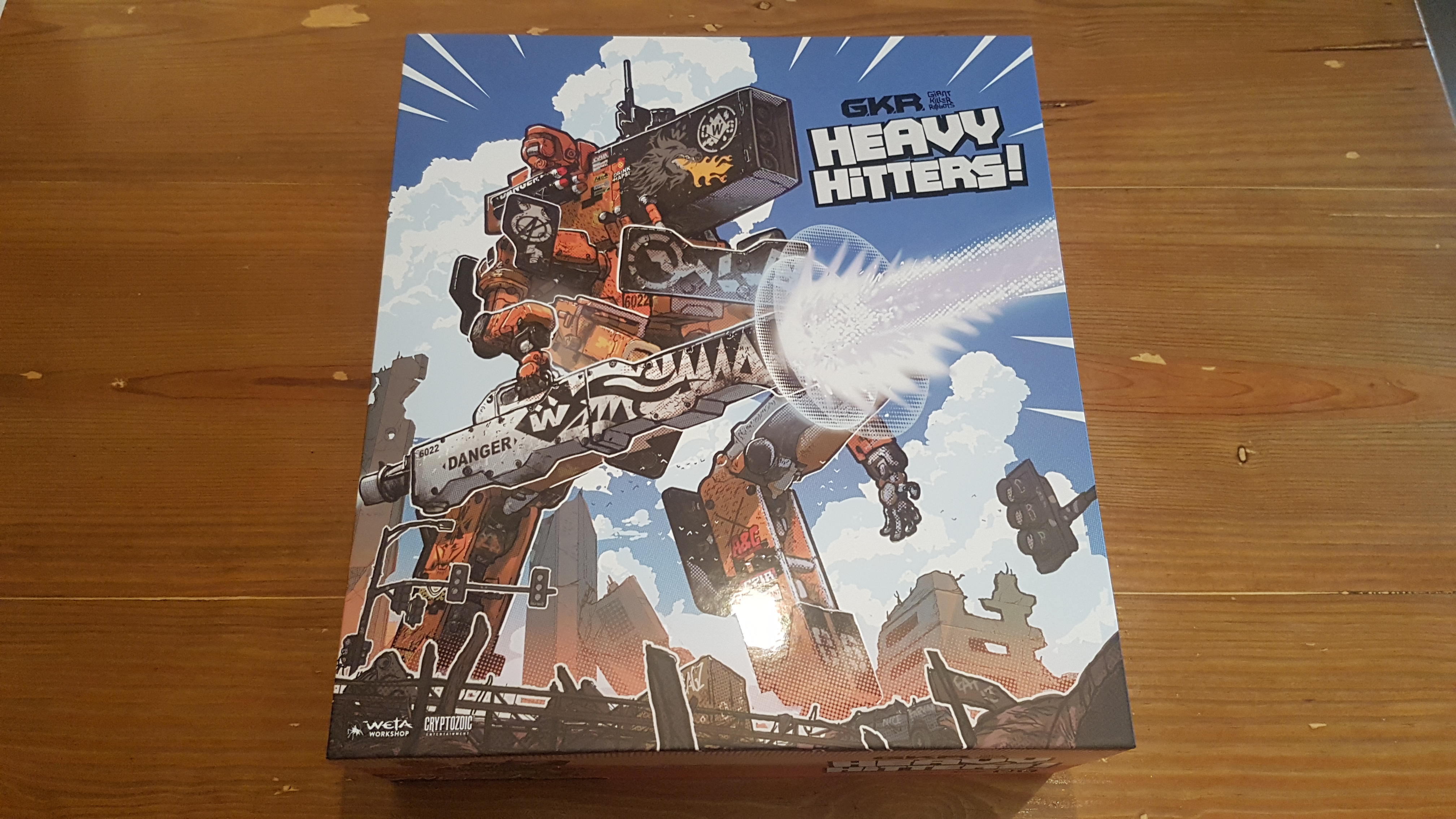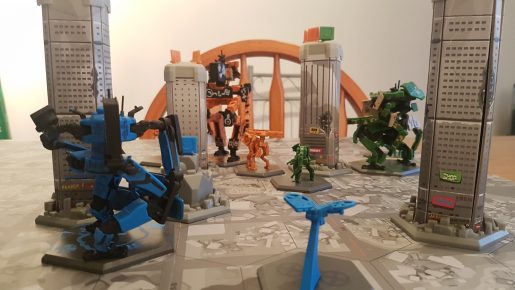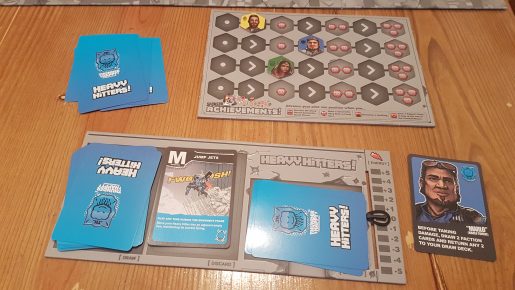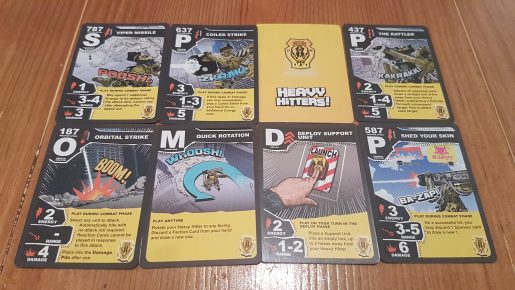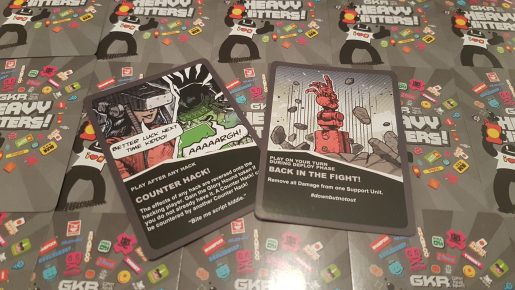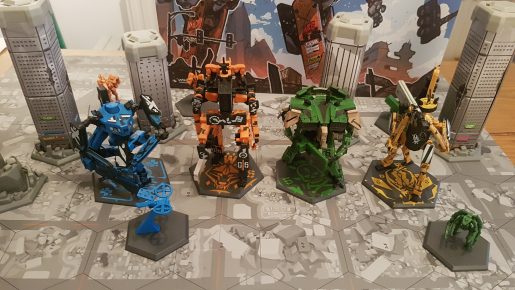GKR Heavy Hitters is a robot/mech-like themed, grid movement based, hand management and dice combat game from Weta Workshop. Designed by Matt Hyra the game was originally funded on Kickstarter and has since, this year, seen retail release. The game plays with 1 – 4 players and is designed to take around 1 – 2 hours, depending on the player count. As the lore goes these Giant Killer Robots (GKR) are in an advertiser spammed combat sport, where abandoned cities are utilised as battlegrounds. However, are your skills as a pilot worth testing? Let’s find out!
For setting the game up the first port of call is the board itself. There are some pre-designed layouts to follow in rulebook but players can also craft their own maps, by varying the placements of buildings. The buildings themselves assemble with ease; being a folded cardboard shaft, with an end cap and a base. By rolling the dice to determine the starting player, referred to as the Glory Hound, each player chooses a faction and gains a heavy hitter.
After this, pilots must be chosen; each offering unique abilities. Then comes deck formation, where players chooses 1 primary weapon set out of 4 and 2 secondary weapon sets out of 5. To this they add up to 5 deploy cards and a selection of powerful orbital strikes, manoeuvre and reaction cards to reach a total deck size of 25. This starts each game off with at least the choice of variance from previous games.
The game is played over rounds of five phases: Deploy, Movement, Combat, Tagging and Reset phases. At the start of each round players set their energy levels to the maximum of 5 and make sure they draw up to a hand of six cards from their deck. The player with the Glory Hound starts the deploy phase off. Each player in turn may deploy a single support unit onto the battlefield. When spawning these support units must be placed with a 2-hexagon range of the player’s heavy hitter and into an empty space. If you play a deploy card this only costs 2 energy, otherwise it’s 4 energy to deploy a support unit. As soon as the unit is spawned the card is placed in the player’s personal discard pile.
In terms of movement, starting with the glory hound players each get to move their Heavy Hitters then going around the table again for Combat support units followed by Repair before Recon. This brings some balance between going first against the ability to see where others have moved to. Moving a heavy hitter costs an energy per hexagon. While players can move through their own units heavy hitters cannot move through opponents’ units, though ending movement on a opponents support unit shoves it backwards (as per the choice of the owner).
Support units have maximum movement values denoted on their cards but do not cost energy to move, something important when balancing limited energy. Like the heavy hitters the repair and combat units cannot move though opponents’ units but the recon can fly over units or buildings. Some manoeuvre cards enable the player to make movements outside of this order, or after regular movement, and can be powerful if timed right.
When it comes to combat this is where throughout the game weapons used will change, cards will have special abilities and upgrades can also affect the outcomes. Boil the combat down to the basics though and it is broken down into 9 simple steps. It might sound a lot, yet each are short and flow from one to another naturally. On top of this after a few rounds you’ll notice whether specific steps are necessary such as checking for achievements.
To start, players declare attacks by playing cards from their hand face down, and any active support unit cards. Attacks each have differing ranges, damage values and some have special factors that take place. The only limiting factors are the energy needed and that the same type of attack card can only be played once per round. Pilots reveal their attacks and pay the energy costs. For each energy a player spends after hitting zero energy they must place a card from their hand or draw pile into their damage pile. Organise your revealed cards into numerical order based on attack speed and you’re already a third of the way through the 9 steps.
Play then goes around the table based upon the attack values of cards, when players must determine if they have a valid attack – based upon range of attacks and line of sight. If all of the shortest paths to the targeted unit are through buildings then the attack is fully blocked, though if only one path is through a building partial cover is awarded. Partial cover means the attacker must roll one higher than normal during the next step. One caveat to the cover rule is an alley shot when the attacking heavy hitter unit is shooting through the middle of two adjacent buildings towards an enemy unit, something that nets an achievement.
For an attack to hit the attacker rolls two dice (d6). To use a Heavy Hitter attack the roll needs to be 5+, while support units need 7+. A roll of double six cannot be defended against whereas a roll of double 1 sees a heavy hitter attack card placed in the damage not discard pile, with support units taking 1 damage. Against a heavy hitter the defender rolls a number of dice equal to the damage value of the attack. For each rolled that is less than the heavy hitters defence stat they take a damage.
Like a critical failure the defender must then place as many cards equal to the damage to their discard pile, either from their hand or draw pile. While you cannot look at the draw pile to determine if it is worth discarding from it you can check whatever you’ve put into your discard pile afterwards. If at any point your draw pile is reduced to zero simply shuffle your discard pile and continue. Support units take damage and their health is tracked on their cards. Take them down to zero and they are simply removed from the battlefield until redeployed.
Combat is over but the round isn’t, as it is now time to tag buildings. Starting with the glory hound each player gets to add a tag to any building that they have a unit next to, with each unit able to tag once. You can replace an opponents tag or put your token into an available empty slot, gaining a sponsorship card per building tagged. Sponsor cards can be seen as bonus providers and the players can only ever have 5 of these in their hand. As soon as a player adds a fourth tag of their own to a building it is destroyed, only the plastic stump remains with a tag of the destroyer and that player moves one space up the achievements board.
Post-tagging is the reset phase, with energy being returned to 5, each player drawing up to a hand of 6 cards if possible and the glory hound moving to whomever placed the most tags. The game ends either with one player destroying a forth building and claiming victory or after the first elimination. Once someone is eliminated scores are calculated for players based upon the number of undamaged cards they have combined with progress along the achievements board to give a winner. An optional variant is to play until only one last heavy hitter remains but this can see some players side-lined for a chunk of time.
The achievement board is one way that upgrades can occur, such as making it easier to hit attacks from heavy hitters. This adds in a wave of complexity but not one that feels out of place. Instead it adds some strategy to movement and attacks, as well as the tagging phase. Players have a choice of whether the increased odds of better rolls are worth striving for early, though especially in non-last robot standing games they can be important for the points. Other aspects that can affect the battle are flanking that sees attacks to the back three sides of heavy hitters get a plus 1 to attack and the plethora of pilot abilities that can each shake up the best way to play.
Something that might not be entirely apparent from images is the size of GKR Heavy Hitters; the huge box it comes in, the scale of the main mechs and the buildings. While it makes fitting the box on a shelf a little tricky, a bit like some big box versions of board games, this scaling helps players get the feeling of the large size of the robots that are battling and the destroyed city. The size also makes it almost impossible for people passing by not to stop and look, as it gifts the game such epic table presence, people are instantly intrigued.
The robots aren’t just spectacular due to their size they also, like the rest of the content in the box, contribute to the fantastic production quality of GKR Heavy Hitters. Each faction has its own silhouette style making them recognisable at a mere glance. On top of this, as someone whom is painfully bad at painting it is glorious to see the main robots coming not only pre-made but pre-painted with details, colour and decals that helps to further differentiate them from one another. The buildings are made of thick cardboard, sandwiched each end by plastic end caps, providing a rigidity that helps them sit perfectly dotted around the board.
Featuring some awesome, almost light-hearted, artworks the faction and sponsor cards don’t just continue they enhance the over-the-top robot combat, utilizing some clean cartoony like illustrations. The bright colours are only matched by the entertaining content of the illustrations which players often during play end up pointing out to opponents. It’s not often the art of the combat genre so perfectly matches the feel of a game.
Utilizing a similar user interface of stats for each card, no matter what type of attack is it, truly helps to keep the game clear. Players don’t have to spend time fully reading each and every card to glean information. Instead pilots, at a quick glance, know exactly what they need; be it the attack speed, damage value or more. It’s nice to see that a balance has been struck between allowing the artwork to shine whilst allowing plenty of room to let the gameplay relevant information to be easily readable.
There is a lot going on and to get your head around, with positioning, directional facing, buildings, attack speeds and more, just for combat. Yet, this depth is something that players can sink their teeth into, making GKR Heavy Hitters an experience that only grows with player experience. Perhaps the achievement board could be a tad clearer for what players need to do but a few rounds in and this will have been picked up. More importantly, the design of the cards and the simplicity of the player boards help the game to be easily understood. Overall, if you’re looking into GKR: Heavy Hitters you’ll see the depth of the movement, combat and strategies and that should be enough to tell you if it’ll be too much for your group. If it isn’t too heavy, then this is a big box that manages to land a powerful experience and has gorgeous enough robots to just about warrant the extreme price tag.
[Editor’s Note: GKR Heavy Hitters was provided to us by Asmodee UK for review purposes. The game is currently available on 365 Games for £97.49. It is also available from local UK board game stores, find your local store here]

